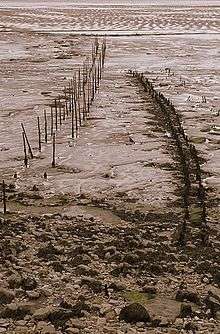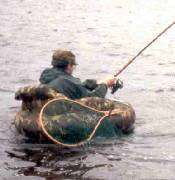Putcher fishing
Putcher fishing is a type of fishing (usually of salmon) which employs multiple putcher baskets, set in a fixed wooden frame, against the tide in a river estuary, notably on the River Severn, in England and South East Wales. Putchers are placed in rows, standing four or five high, in a wooden "rank" set out against the incoming and/or outgoing tides.[1]

Traditionally the putcher was made of hazel rods with withy (willow) plait, both materials being grown locally on the Caldicot and Wentloog Levels. Modern baskets made of steel or aluminium wire were introduced in the 1940s and 1950s.
History
The trapping of fish is probably one of the oldest known forms of fishing. The exact origin of putcher fishing along the River Severn is not known, but a memorial song recorded in 1663 mentions two fixed engines operating "between the Hill and the Pile" – undoubtedly references to Hill Farm and the Pill Reen or "Monksditch" at Goldcliff. Evidence for the use of putchers in medieval times has recently been revealed during construction of the Second Severn Crossing [2]
A salmon fishery of some kind was probably in operation at the time of the Priory at Goldcliff and then passed, at the time of the Dissolution, to Eton College. In the 1920s there were ranks holding some 2,400 baskets. The revenue from this enterprise provided an endowment to the Church of the Blessed Virgin at Eton. In addition, fresh salmon were provided for the breakfast of the scholars at the college. The fishery was owned for much of the later part of the twentieth century by Mr John Williams who employed one full-time fisherman Mr Wyndham Howells. The lease for the fishery was subsequently taken over by a Newport fishmonger. The fishery at Porton was acquired in 1902 by the Pontypool Park Estate and was for many years run during the fishing season run by Mr Keyte, a member of a long-established family of Goldcliff farmers.[3]
Fish traps in Wales
During the later half of the twentieth century numerous fixed weirs, installed in rivers and shores throughout Wales for the purpose of catching fish, fell into disuse. In addition to fixed traps, however, Wales had many removable traps, also known as "hecks", "crucks", "cribs" and "inscale". The basket traps used at Goldcliff and Porton in the Severn Estuary were known as "putchers".[3]
Fishing for salmon using many of these devices was forbidden in England and Wales by the Salmon Fishery Acts of 1861 and 1865, except under grant or charter, or by the right of "immemorial usage". Indeed, Special Constables were appointed by the Act of 1865 to enquire into the legality of all "fixed engines" being used to catch salmon. Only if proven legal would the constables then issue a certificate of legality. In this way the number, size and position of all salmon weirs became fixed for all time.[3]
Goldcliff and Porton
In South East Wales the baskets at Porton and Goldcliff came under the jurisdiction of the Usk River Authority and were permitted to be used as "privileged fixed engines". Two others at nearby Undy and Redwick, also on the shoreline of the Severn Estuary, fell out of use on the 1930s. The Wye River Authority operated a weir of 500 baskets at Beachley in Gloucestershire and a number of other weirs were operated by the Severn River Authority on both sides of the River Severn.
From 1913 to 1950 fisherman George Whittaker was employed at the Goldcliff Fishery, first by Mr Fennell and later by Mr Burge. Whittaker was to become a notable source of information about putcher fishing there.[4] The Putchers at Goldcliff were traditionally open in weave, being constructed from hazel rods and withy saplings cut in the autumn from a 6-acre (2.4 ha) withy plantation at Llanwern. The baskets were made and repaired by the fishermen themselves during the closed season between 14 August and 1 May. The wooden putcher was gradually superseded, from 1942, by galvanised steel wire baskets and then later by baskets of aluminium wire, both of which were more seawater resistant. After 1952 the baskets at Goldcliff and Porton were exclusively aluminium, although the traditional measurements were strictly adhered to by the modern manufacturers. The galvanised putchers with 3-inch (76 mm) square mesh were supplied flat and wired into shape by the fishermen. The aluminium putchers, with a diamond mesh, were supplied ready-formed, although at Goldcliff they were strengthened with additional wire bands. All-wire putchers were fixed to the wooden ranks by means of the two staples hammered into the wooden rails on the ranks.[3]
Somerset
Since the 18th century salmon fisheries were associated with the Clifford estate at Yearsey and Black Rock at West Stretcholt. By the mid 19th century the de Mauley family claimed three sites in the River Parrett near Pawlett, Cannington, and Black Rock where four men had 1,000 putchers, also called "butts". Between 1868 and 1873 the number of licensed butts fell from 1,360 to 450. Salmon putchers remained in the river in 1920 and were sold with the de Mauley estate.[5]
Putcher construction
Willow was harvested using traditional methods of pollarding, where a tree would be cut back to the main trunk. New shoots of willow, called "withies", would grow out of the trunk and these would be cut periodically for use.
In 1970 a few dozen of the traditional willow baskets were made and installed by the fishermen at Goldcliff. To make a putcher by hand, a low bench was used approximately 18 inches (460 mm) high and 24 inches (610 mm) square into which 9 holes were made, in a circle 10 inches (250 mm) in diameter. Green withy or hazel rods were then split into three using an oak cleaver held in the maker's hand.[4] The split lengths were then inserted into the holes to make a conical shape and a withy ring was plaited round them close to the surface of the bench. Nine shorter rods, either complete or in thirds, were then inserted into the ring, with two more rings being plaited around to secure them, one halfway up and another near the top. A nose ring was then plaited. The putcher was then pulled out of the bench, the nose ring attached and a spiral `worm' was added from the narrow end to the middle.[4] A base ring was woven at the end of the basket. Any longer rods could then be trimmed and the basket was ready for use. The basket was expected to last for two fishing seasons, possibly also for a third following repair.
Ranks
A strong timber frame or "rank" was required to hold the rows of putchers, built across the main tidal flow of the river. The fish, with fins trapped by the weave and unable to easily swim backwards, were then trapped in the conical baskets. The very high difference between high and low tide in the Severn Estuary enabled the ranks to be long and thus economically productive. Goldcliff originally had three ranks – the "Flood", the "Ebb" and the "Putt", able to carry a total of 2,327 baskets.[3] A number of smaller baskets were especially constructed to fill any smaller spaces in the rank. Although there was no great advantage to be had from trapping smaller fish, the lack of any holes in the rank presented a more complete "wall of traps" through which it was more difficult for any fish to pass. The single putcher rank at Porton could carry some 600 baskets. Although the fishermen's intimate knowledge of the seasonal height of the tides meant wasted that un-submerged baskets were not set, once fixed the baskets were typically removed only if the fish could not be released, or to allow repairs.
The uprights of the ranks were generally made of green larch or green elm, some 15 feet (4.6 m) long and from 8 to 9 inches (230 mm) in diameter and sunk into the foreshore by between 6 and 8 feet (2.4 m). Green timber was preferred as the salt seawater would preserve it and allow use for perhaps up to ten years. Elm tended to be more durable then larch, although all would eventually start to rot from the top and would need to be replaced. Some poles at Goldcliff, probably those at the seaward ends of the ranks, were reported to have lasted for forty years. The post holes were bored using a rock auger and bar, with the debris removed using a long-handle implement called a "spoon". The uprights were then beaten into the ground, in pairs, five feet apart, using an iron lined yew beetle.[3]
Between each pair of upstream and downstream uprights a space of six feet was left for laying the baskets, with each pair braced with diagonals and transverse beams top and bottom. To the outside of this structure horizontal rails were then nailed, the first some 18 inches (460 mm) from the ground, and then at regular two foot intervals above Two or three narrow gaps were left in the lower rails to allow access. Rows of baskets were then stapled to the rails, at a downward angle of about 20 degrees. All the baskets in a rank would point the same way, with the open end set either against the incoming or outgoing tide. Added strength was given to some ranks by using angled props against the front post of every fourth pair.
Fishing practices

For reasons of religious observance, until the early years of the nineteenth century, the putchers' open ends had to be closed at least between noon on Saturday until 6 am the following Monday. The practice suggested strongly the origins of the fishery with the Benedictine Priory at Goldcliff.
On normal fishing days, as soon as the tide had exposed the baskets, they needed to be inspected by the fisherman who used a pronged staff to push any trapped fish back towards the basket entrance. Returning along the other side of the rank, the fish were then collected in a sack. At Goldcliff a bicycle, with trays front and back, was used to make collection easier. Running repairs could also be carried out at the same time with hammer and nails.
Fish from the ebb-ranks were by necessity fresher than those taken from the flood-ranks, since on the latter the tide had to both rise and fall before the fishermen could collect the catch.
Since the fisherman would need to work with the tides, inspection and collection needed to occur around the clock and thus the brick workshop was equipped with bed and cooking equipment. A fish store was also required where the freshly collected fish could be stored in tight-lidded lead-lined boxes packed with broken ice. The fish from both Goldcliff and Porton were sent to Billingsgate market in London. The Porton fishery was also equipped with a smokery at one time, using oak shavings, but this venture was apparently not long lasting.[3]
The "kype", a basket similar to the putcher but more elaborate, for catching shrimp and eel, seems also to have been constructed for use at Goldcliff.[4]
See also
- Eel basket
- Fish trap
- Basket weaving
- Snare trap
References
- Putcher Use in the Severn Estuary
- Goldbold, R.C. and Turner, R.C. (with contributions by Hillam, J., Johnson, S. and O'Sullivan, A.), Medieval Fishtraps in the Severn Estuary, Medieval Archaeology, Vol 38, 1994, pp 19-54. Publisher: Maney. ISSN 0076-6097.
- Jenkins, J. Geraint, Commercial Salmon Fishing in Welsh Rivers. Folk Life - Journal of the Society of Folk Life Studies, Vol 9, 1971
- Hando, F.J., (1958) "Out and About in Monmouthshire", R. H. Johns, Newport
- Baggs, A. P.; Siraut, M. C. (1992). Pawlett: Economic History. A History of the County of Somerset: Volume 6: Andersfield, Cannington, and North Petherton Hundreds (Bridgwater and neighbouring parishes). pp. 273–275. Retrieved 8 January 2017.


